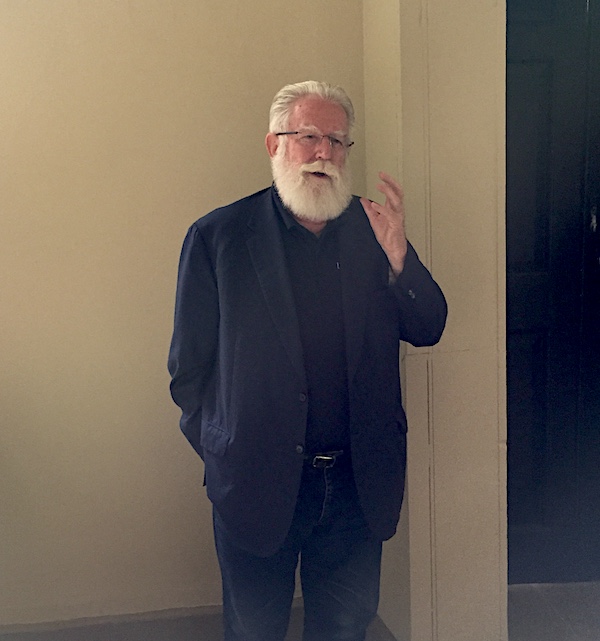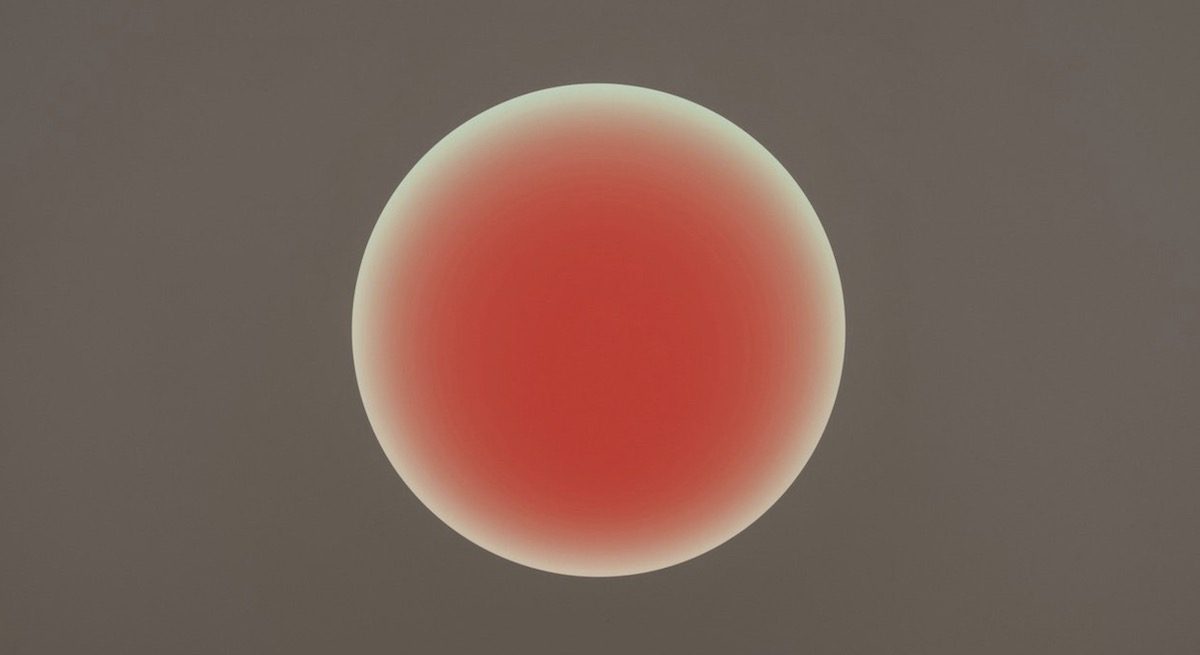New works by Light and Space master James Turrell is to go on show at Pace in London 6 Burlington Gardens 11 February to 27 March 2020. Turrell is among the most influential artists of the past fifty years and Pace is proud to continue its long commitment to him stretching back to 1967. This is the gallery’s ninth exhibition of Turrell works.
James Turrell has dedicated his practice to what he has deemed perceptual art, investigating the materiality of light
By the notion of phenomenology in pictorial art, Turrell focused, in his earliest work, on the dialectic between constructing light and painting with it, building on the sensorial experience of space, colour, and perception. These interactions became the foundation for Turrell’s oeuvre, which evolved into an investigation of the immateriality of light itself.
Turrell’s exhibition at Pace features three new works from the Constellation series staged in site-designed chambers. The works will feature elliptical and circular shapes with a frosted glass surface animated by an array of technically advanced LED lights, which are mounted to a wall and generated by a computer programme. The light changes are subtle and hypnotic, one colour morphing into the next. The programme runs on a loop that is imperceptible to the viewer, prompting a transcendental experience. With these new works, Turrell continues his exploration of technological possibilities combined with sensory practices and gradient colours.

“To some degree, to control light, I have to have a way to form it, so I use form almost like the stretcher bar of a canvas… When I prepare walls, I make them so perfect that you actually don’t pay attention to them. This is true of the architecture of form I use: I am interested in the form of the space and the form of territory, of how we consciously inhabit space.” James Turrell.
Since his earliest Projection Pieces (1966–69), Turrell’s exploration has expanded through various series, including Skyspaces (1974–), Ganzfelds (1976–), and perhaps most notably, his Roden Crater Project (1977–) near Flagstaff, Arizona. Representing the culmination of the artist’s lifelong research in the eld of human visual and psychological perception, Roden Crater is a controlled environment for the experiencing and contemplation of light and stars, a shared interest with Pace’s exhibition in London. Fundraising is underway to complete the construction and open it to the public.
Turrell’s practice has equally materialized in small-scale works, including architectural models, holograms, and works on paper. His inspiration draws from astronomy, physics, architecture and theology.
James Turrell: Passages of Light is currently on view until 29 March 2020 at Fundación Jumex, Mexico City.
James Turrell (b. 1943, Los Angeles) attended Pomona College, where his studies concentrated on psychology and mathematics. Since 1966, he has created artworks made primarily out of light. In 1973 he received a master’s degree in art from Claremont Graduate School.
His work is represented in international public collections including Tate Modern, London; Los Angeles County Museum of Art; Museum of Fine Arts, Houston; the Solomon R. Guggenheim Museum, New York; Whitney Museum, New York; Chichu Art Museum, Naoshima Island, Japan; The Museum of Modern Art, New York; and the Israel Museum, Jerusalem.
Turrell’s first one-person exhibition, James Turrell: Light Projections, was held in the fall of 1967 at the Pasadena Art Museum, curated by John Coplans. An accompanying catalogue essay, written by Coplans, was also published in the October 1967 issue of Artforum. This seminal exhibition positioned Turrell at the forefront of the Light and Space movement and set the stage for nearly 200 one-person exhibitions and 250 group shows worldwide.
Notable recent one-person exhibitions include James Turrell, held at the Solomon R. Guggenheim Museum, New York (2013) as well as James Turrell: The Light Inside, Museum of Fine Arts, Houston (2013). These exhibitions were held concurrently with James Turrell: A Retrospective, organized by the Los Angeles County Museum of Art, California (2013), which subsequently travelled to the National Gallery of Australia, Canberra (2014), before closing at the Israel Museum in Jerusalem (2015). Another retrospective of his work was exhibited at Mass MoCA, North Adams, Massachusetts (2017). In 2018, The Substance of Light was organized by Museum Frieder Burda, Baden- Württemberg, Germany (2018), and in 2019 Asia Society, Hong Kong, presented Yukaloo.
In addition to twenty-two, permanent installations at institutions such as the Henry Art Gallery, Seattle; Fine Arts Museums of San Francisco, de Young Museum; and P.S. 1, Long Island City, New York, James Turrell’s work is held in over eighty collections throughout the United States and abroad. In 2009, the Hess Art Collection inaugurated the James Turrell Museum in Colomé, Argentina, housing a collection devoted exclusively to the artist’s oeuvre.

Turrell has been the recipient of numerous awards and honours throughout his artistic career, beginning with a grant from the National Endowment for the Arts (1968, 1975). Turrell received a Guggenheim Fellowship (1974), which, coinciding with the loss of his studio, allowed him to initiate the Roden Crater Project. Other awards and honours include the John D. and Catherine T. MacArthur Foundation Fellowship (1984); Chevalier des Arts et des Lettres (1991); as well as the Commandeur de l’Ordre des Arts et des Lettres (2006), conferred by the French government. Turrell was elected member of the American Academy of Arts and Letters, New York (2011), and presented with the National Medal of Arts, awarded by President Obama (2013). In 2017, Turrell received The School of the Museum of Fine Arts at Tufts University Medal Award.
James Turrell has received honorary doctorates from several academic institutions, including the Art Institute of Chicago (1999); Claremont Graduate University, California (2001); Royal Academy of Art, London (2002); and Pratt Institute, New York (2015).
Influenced by the notion of pure feeling in pictorial art, Turrell’s earliest work focused on the dialectic between constructing light and painting with view, building on the sensorial experience of space, colour, and perception. These interactions became the foundation for Turrell’s oeuvre. Since his earliest Projection Pieces (1966–69), his exploration has expanded through various series, including Skyspaces (1974–), Ganzfelds (1976–), and perhaps most notably, his Roden Crater Project (1977–) near Flagstaff, Arizona.
Applying through an advertisement in the back of Artforum Turrell entered graduate school in the fall of 1965 at the newly established University of California at Irvine, where he studied under artists Tony DeLap, John McCracken, and David Gray as well as with art historians John Coplans and Walter Hopps. During this time, Turrell produced some of his first light sculptures, using gases to create flat flames that burned in even colours. These early works proved challenging to control, halting further experimentation in the medium.
In 1966 Turrell rented a studio space in the former Mendota Hotel in Ocean Park, California, where he began to work with high-intensity projectors as a light source, producing the first of his Projection Pieces, Afrum-Proto, in the spring of 1966. Shortly after that, Turrell decided to focus exclusively on his practice and abandoned his graduate studies. From the end of 1968 to 1969 he participated in the Art and Technology program at the Los Angeles County Museum of Art, which brought contemporary artists together with engineers. Alongside fellow artist Robert Irwin and psychologist Dr Edward Wortz, Turrell studied the optical phenomenon known as the Ganzfeld effect—the loss of perceptive fields through sensory deprivation. These studies of perceptual anomalies further ignited his interest in the celestial realm, and he began to incorporate aviation into his practice by creating sky drawings with the artist Sam Francis.
Turrell’s first one-person exhibition, James Turrell: Light Projections, was held in the fall of 1967 at the Pasadena Art Museum. Curated by John Coplans, an accompanying catalogue essay was also published in the October 1967 issue of Artforum. This seminal exhibition positioned Turrell at the forefront of the Light and Space movement.
The artist set out to create architectural sites in which the sun and the moon are brought into intimate spaces, theatres similar to his Autonomous Structures made of concrete and stone. In addition to twenty-two permanent installations at institutions such as the Henry Art Gallery, Seattle; Fine Arts Museums of San Francisco, de Young Museum; and P.S. 1, Long Island City, New York, Turrell has worked on his Roden Crater Project (1977–), a large-scale work in a volcanic cinder cone in the Painted Desert region of northern Arizona. Situated in the basin of a 400,000-year-old extinct volcano the Roden Crater Project was initiated after Turrell received a Guggenheim Fellowship award in 1974, which coincided with the loss of his Santa Monica studio. He immediately set out to find a site framed in a geologic stage of time at an altitude that would “increase a sense of close-in celestial vaulting from the bottom of the crater.” Turrell’s practice has equally materialized in small-scale works, including architectural models, holograms, and works on paper.
Top Photo: James Turrell ‘Aquarius, Medium Circle Glass’ 2019 ©james Turrell
James Turrell 11 February – 27 March 2020 Pace Gallery, London 6 Burlington Gardens, W1S 3ET London

